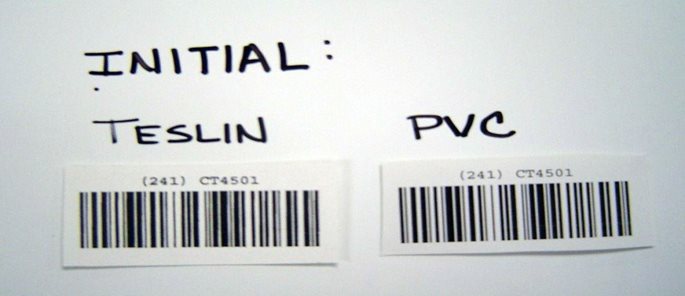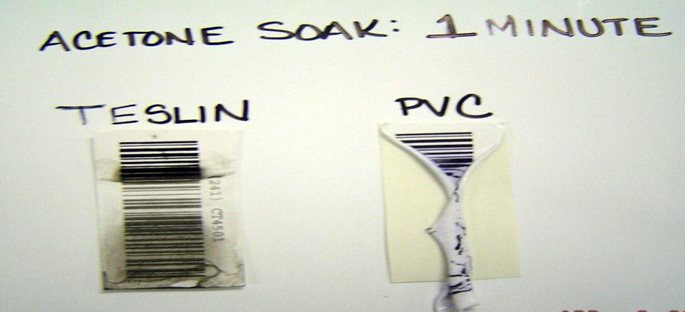PPG TESLIN® substrate is composed of a very high molecular weight polyolefin phase and a filler phase, which is primarily silica. The compatibility of
Teslin substrate with solvents and reagents reflects this dual composition.
Inorganic acids generally have little effect on the dimensions and mechanical properties of
Teslin substrate even at elevated temperatures (e.g., 122°F / 50
oC). Certain organic acids can cause swelling of the polymer. Strongly oxidizing acids, e.g., concentrated nitric and fuming sulfuric acids, will attack the polymer phase and lead to embrittlement and loss of properties of
Teslin substrate. Hydrofluoric acid will dissolve the silica filler leading to shrinkage of product. A portion of the filler in
Teslin HD substrate grade is acid sensitive; therefore, these grades are not recommended for contact with acids. Aqueous solutions of acidic or neutral salts generally do not affect the dimensions or physical properties of
Teslin substrate.
Bases with a pH less than approximately 8.5 have little effect on the dimensions of
Teslin substrate. Alkali bases (e.g., sodium or potassium hydroxide) with a higher pH or elevated temperatures will attack the silica filler and lead to shrinkage as the silica is removed from the sheet. Elevated temperatures may also lead to dimensional changes with weaker bases.
Polar solvents, e.g., alcohols and esters, typically have little to no effect on the dimensions or physical properties of
Teslin substrate. Some discoloration has been noted when highly colored impurities in such solvents are absorbed on the silica in
Teslin substrate. Chlorinated organic and aromatic solvents -- generally the most aggressive organic solvents -- cause swelling of
Teslin substrate and some loss of tensile properties.
Results of chemical exposure testing are reported below. PPG Industries presents this data for guidance in the use of
Teslin substrate. Samples should be tested under actual or simulated use conditions to confirm the stability of
Teslin substrate in the proposed environment.
Chemical Resistance of PPG TESLIN® SP1000 Substrate at 70°F (21oC)
| |
Conc., |
Contact |
Effect on |
| Chemical |
% |
Time, Hr. |
Strength |
Color |
Dimension |
| Nitric Acid |
10 |
100 |
None |
None |
--- |
| Nitric Acid |
70 |
10 |
Some |
Some |
--- |
| Phosphoric Acid |
10 |
10 |
None |
None |
--- |
| Hydrochloric Acid |
37 |
1000 |
None |
Slight |
--- |
| Sulfuric Acid |
10 |
1000 |
None |
None |
--- |
| Sulfuric Acid |
96 |
1000 |
None |
Slight |
--- |
| Ammonium Hydroxide |
28 |
1000 |
None |
None |
Shrinkage |
| Sodium Hydroxide |
40 |
1000 |
Some |
None |
Shrinkage |
| Methyl Ethyl Ketone |
100 |
1000 |
None |
None |
--- |
| Toluene |
100 |
1000 |
None |
None |
Slight Swelling |
| Glycerol |
100 |
1000 |
Some |
None |
Swelling |
| Ethyl Acetate |
100 |
1000 |
None |
None |
--- |
| Tetrahydrofuran |
100 |
1000 |
None |
None |
--- |
| Xylene |
100 |
1000 |
None |
None |
--- |
24-Hour Solvent Resistance of TESLIN® SP1000 Substrate at 70°F (21oC)
| |
Effect On |
| Preferred Solvents |
Length |
Thickness |
| Methanol |
None |
None |
| 2-Propanol |
None |
None |
| n-Butyl Alcohol |
None |
None |
| n-Propanol |
None |
None |
| Acetone |
None |
None |
| Ethyl Acetate |
None |
None |
| Methyl Ethyl Ketone (2-Butanone) |
None |
None |
| Hexane |
None |
None |
| Petroleum Ether |
None |
None |
| Tetrahydrofuran |
None |
None |
| Use Sparingly |
|
|
| n-Hexyl Alcohol |
None |
Slight |
| Methylene Chloride |
None |
Slight |
| Mineral Spirits |
Slight |
None |
| Toluene |
Slight |
None |
| Xylene |
Slight |
None |
| Kerosene |
Slight |
None |
| Avoid If Possible |
|
|
| Glycerol |
Some |
None |
| Isobutyl Acetate |
None |
Some |
'
Chemical Resistance Testing of Pressure-Sensitive Adhesive Labels
The chemical resistance testing was done by soaking both the PVC-based PSA label and a Teslin substrate-based PSA label in the desired solvent for one minute. The PVC-based PSA label was unable to withstand both the acetone and the X-22, but the Teslin substrate-based PSA label held firmly to the backing and the adhesive in both tests. The X-22 did have more of an effect on the print of the Teslin substrate-based PSA label, but the barcode was still readable.

Initial samples
 Samples after 1 minute soak in acetone
Samples after 1 minute soak in acetone

Samples after 1 minute soak in X-22